
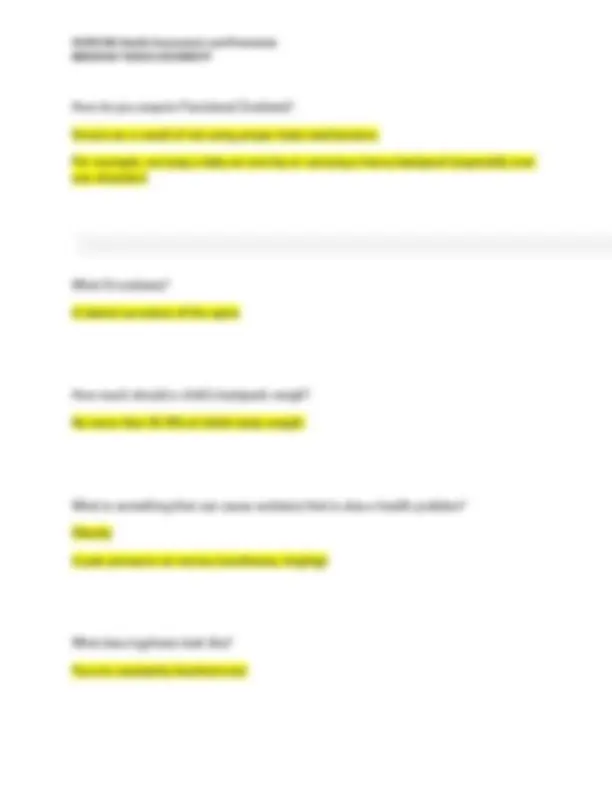
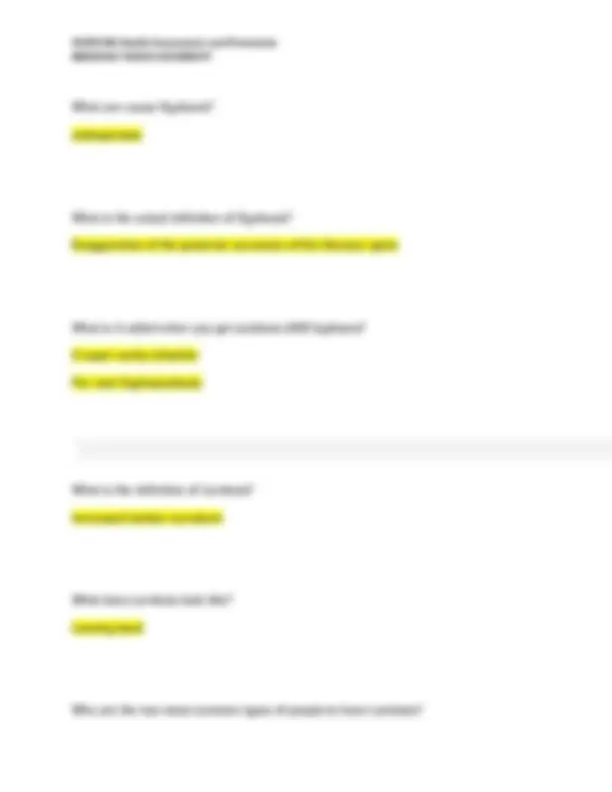
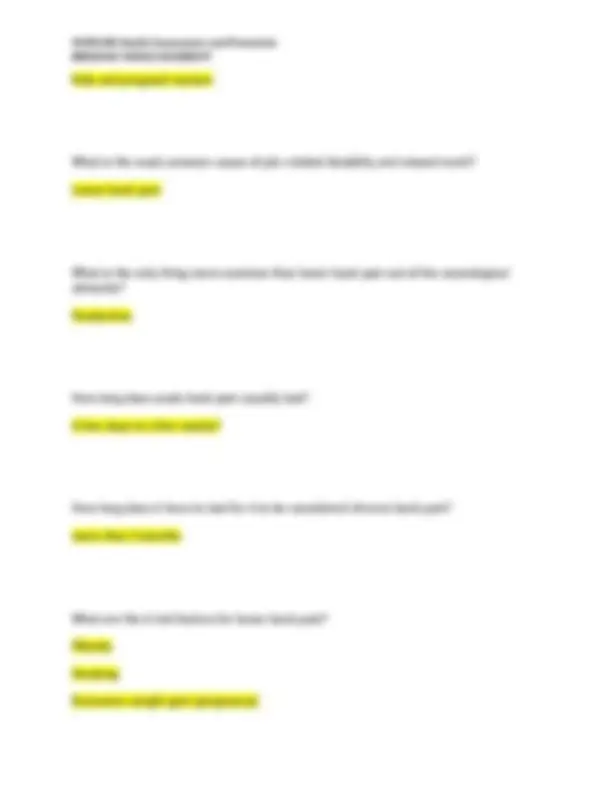

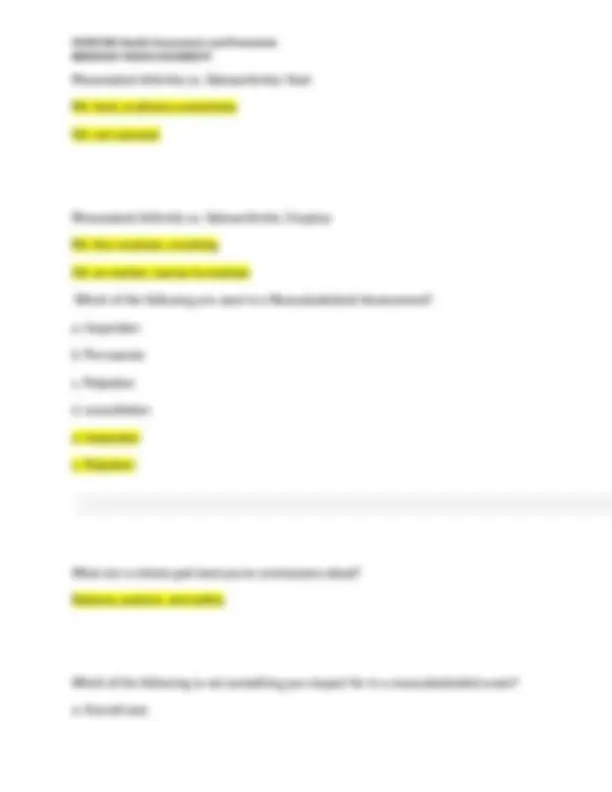
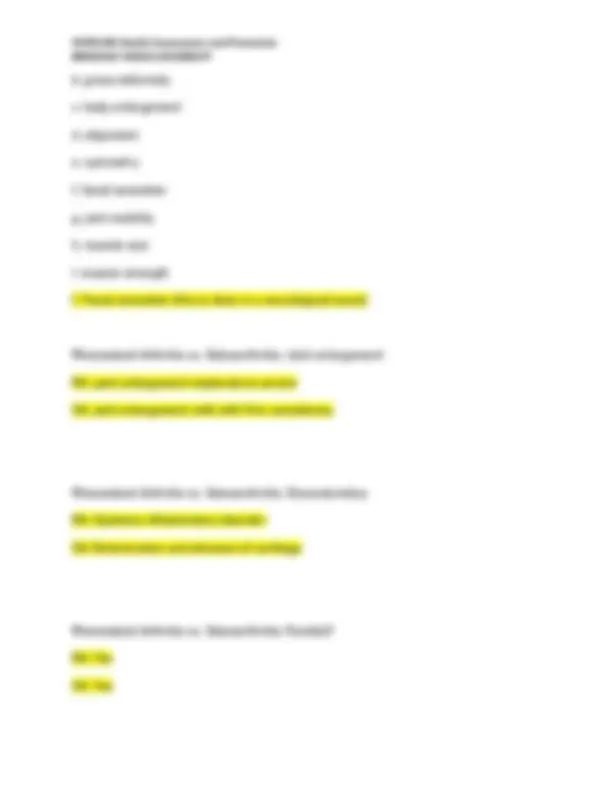

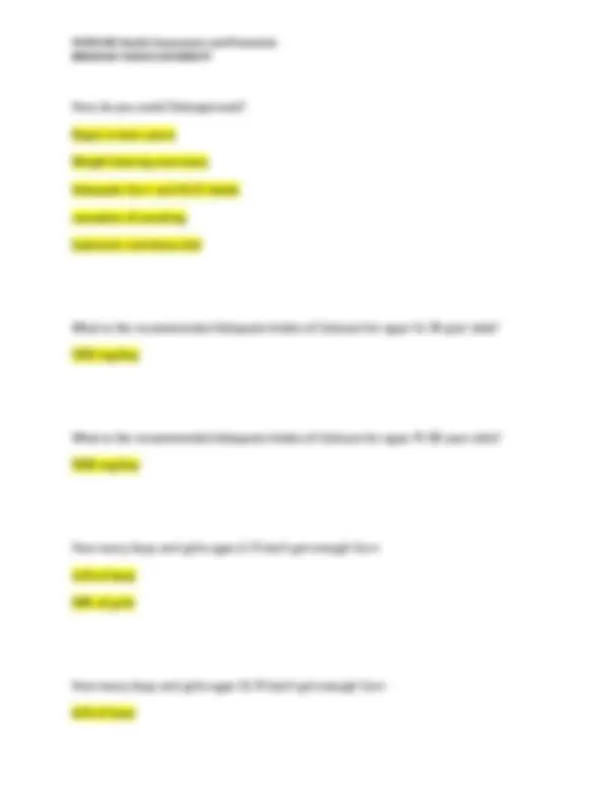
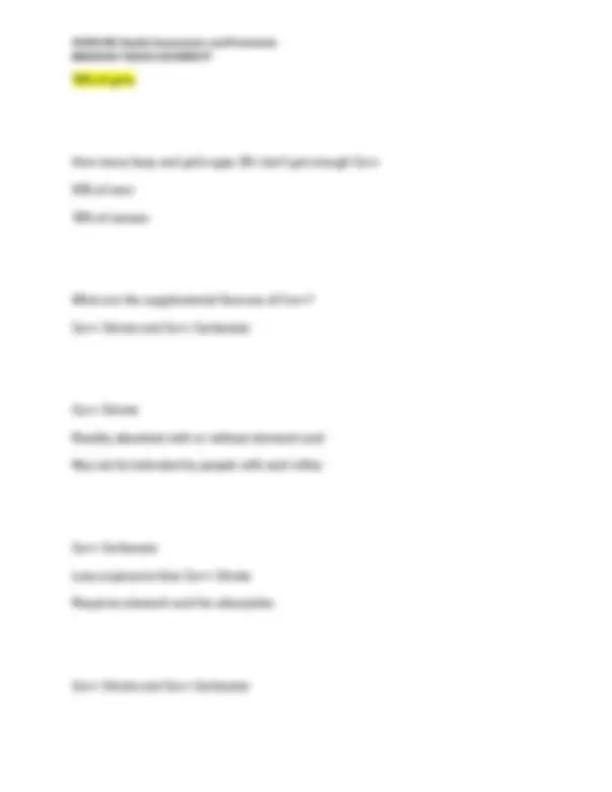
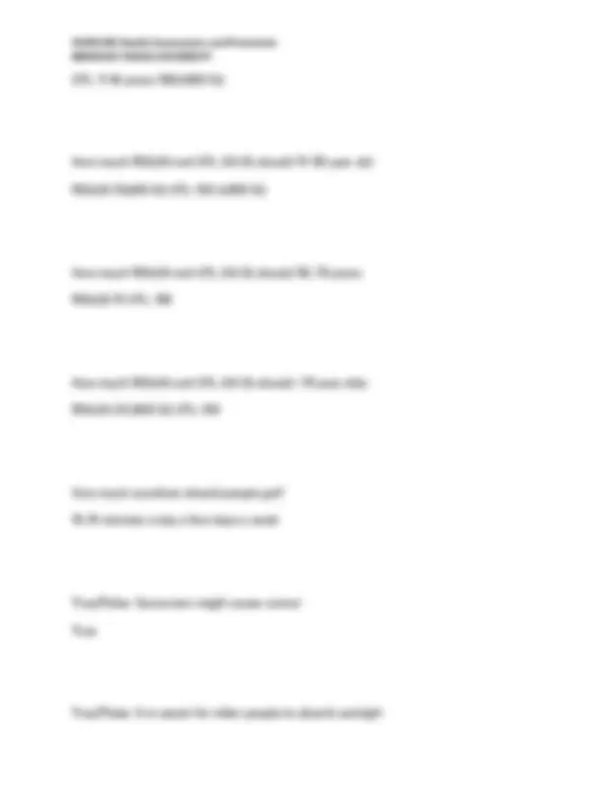
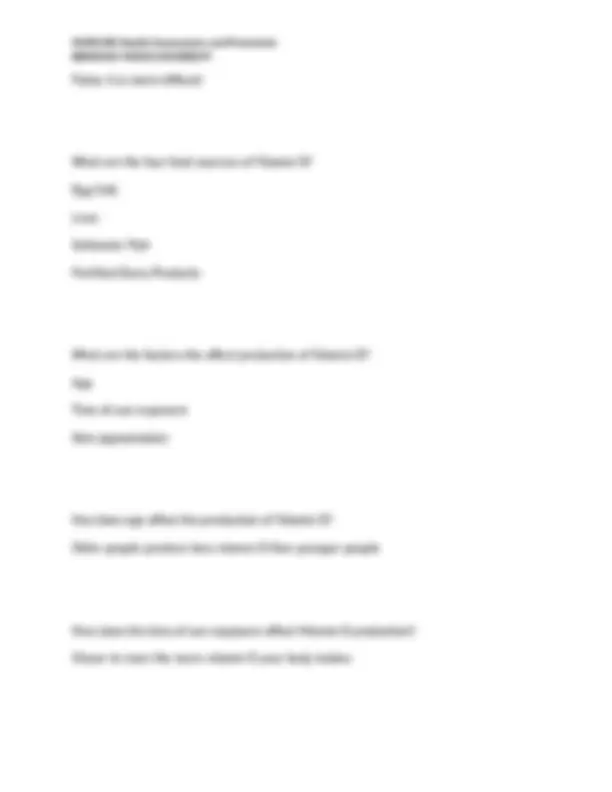
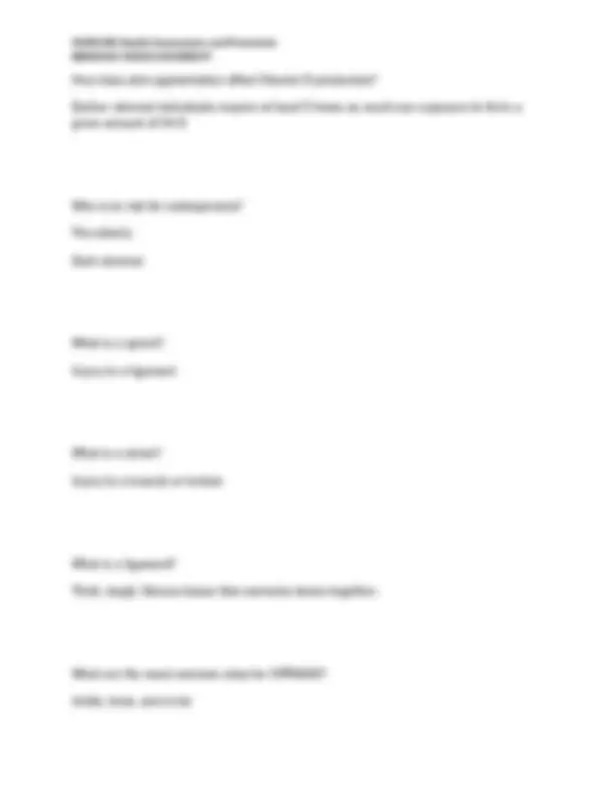
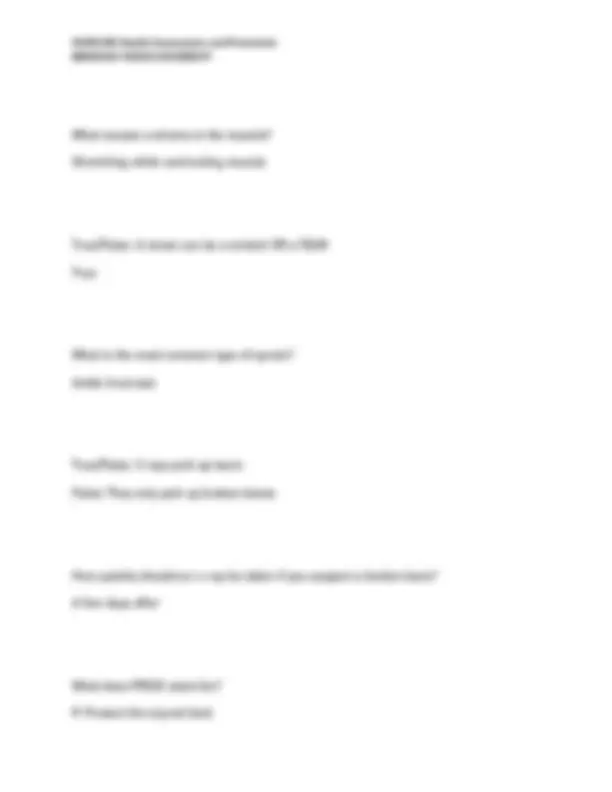
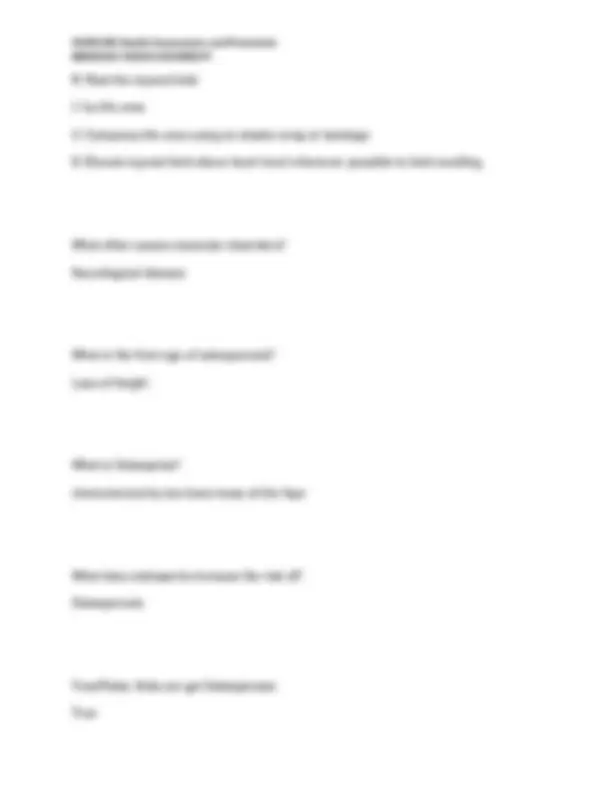
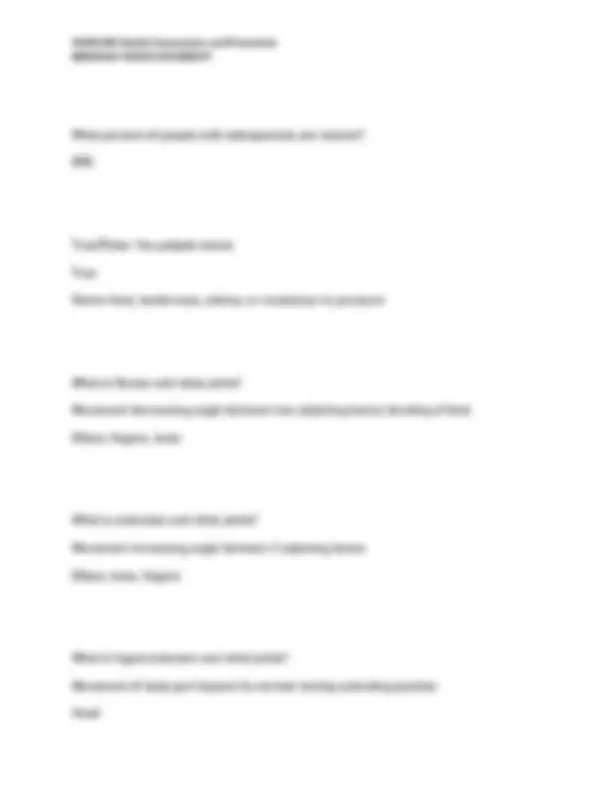
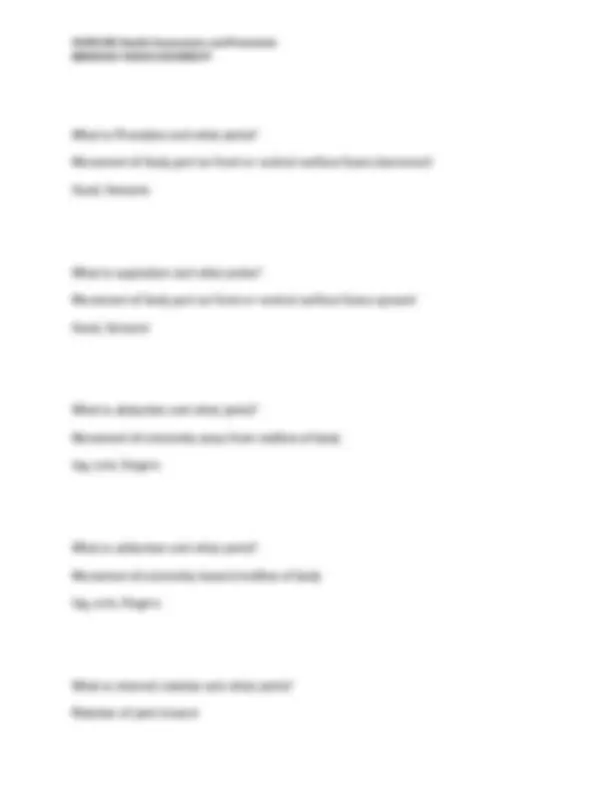

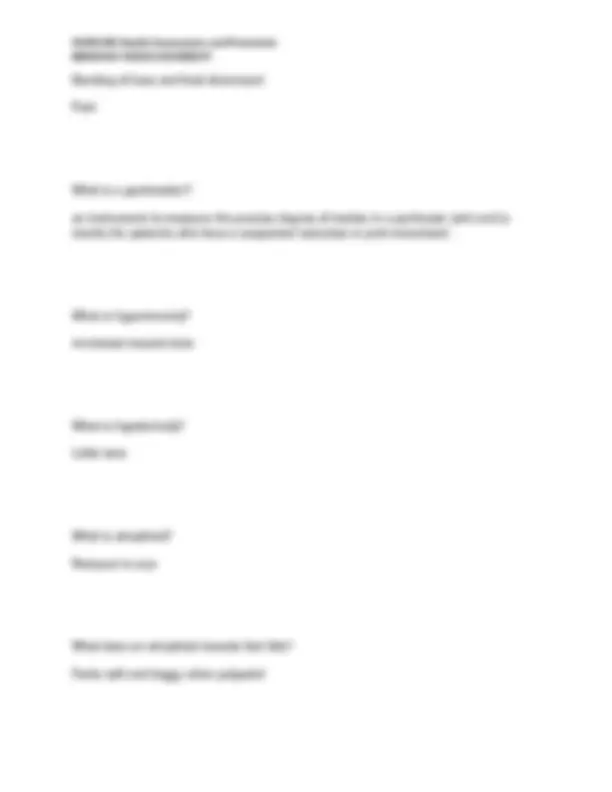
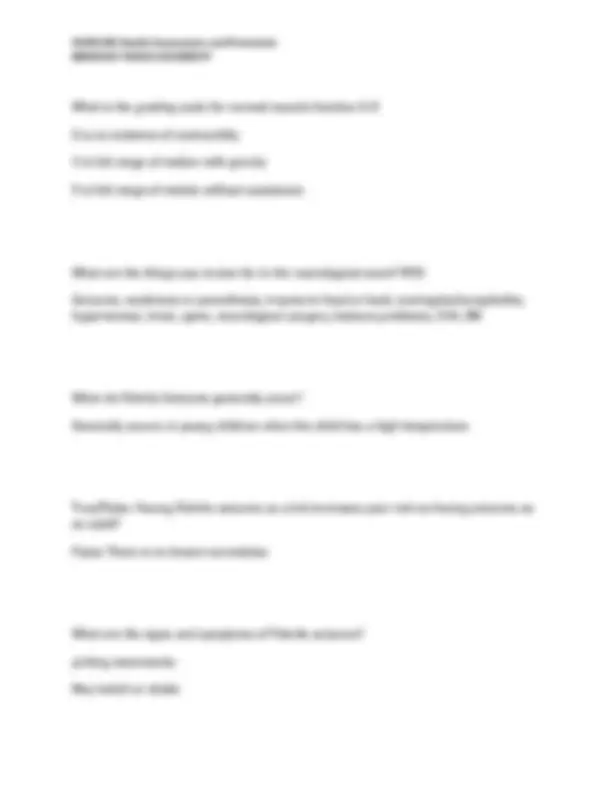
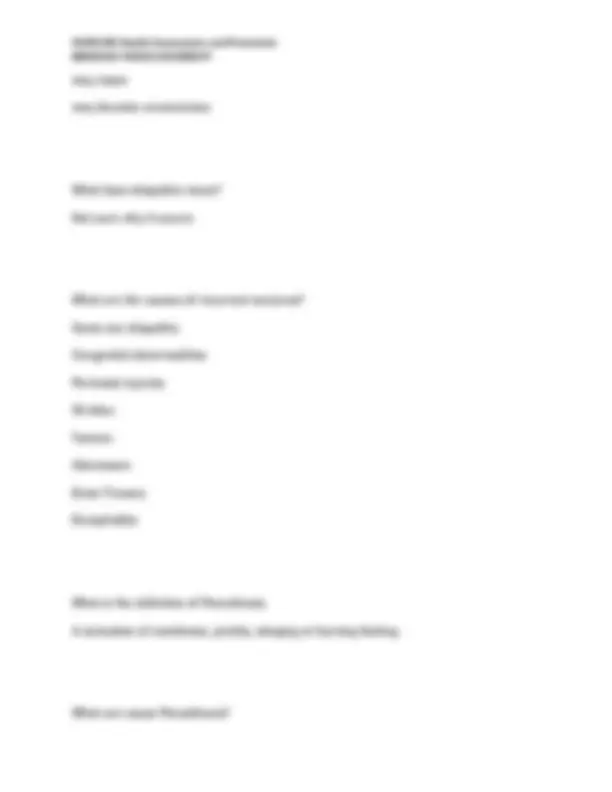
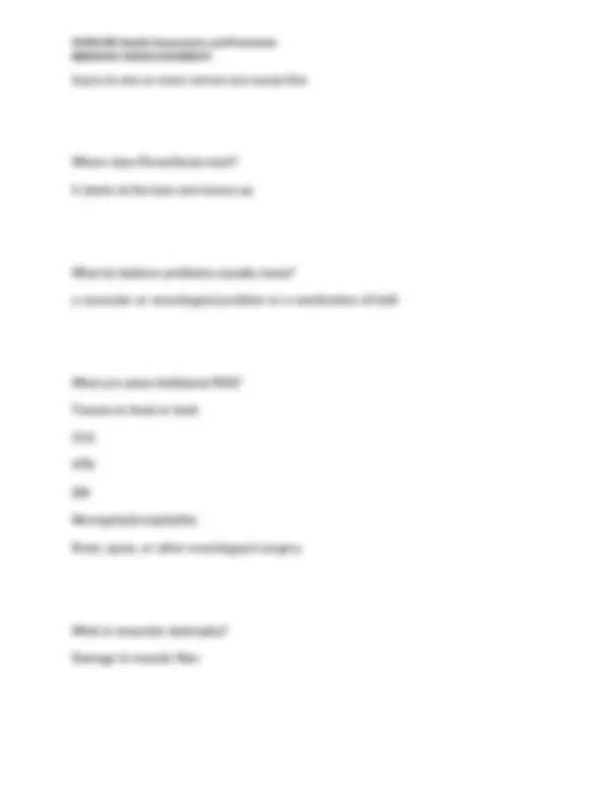

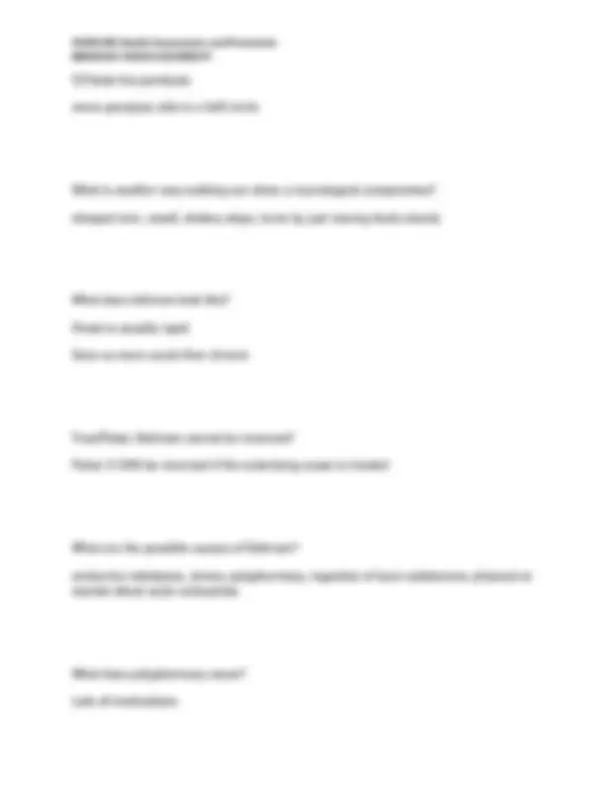

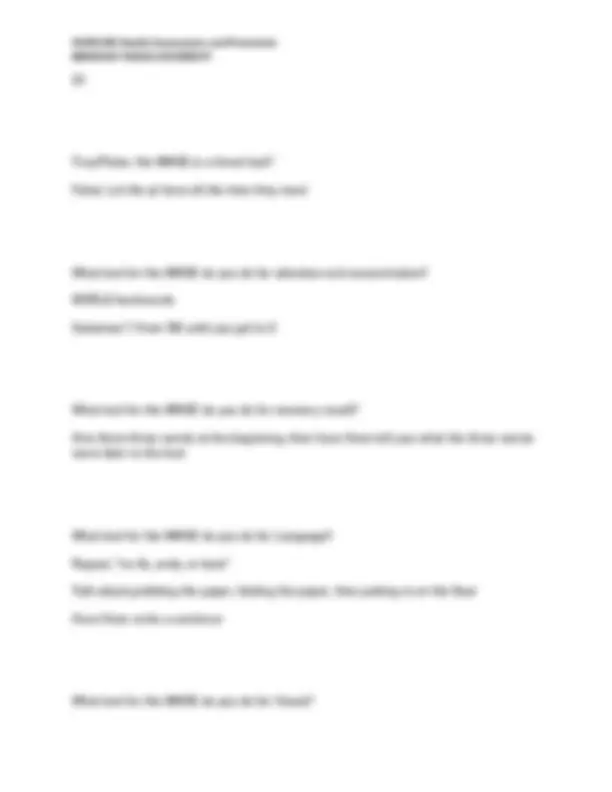
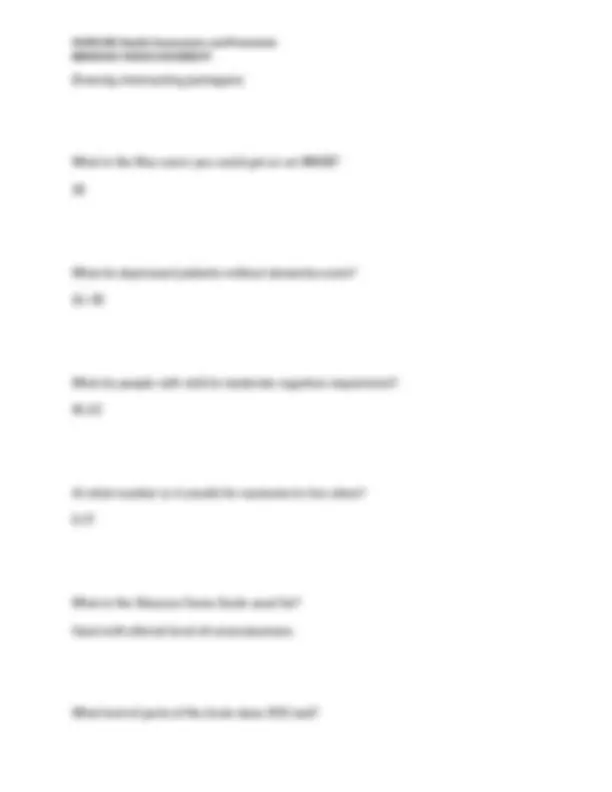
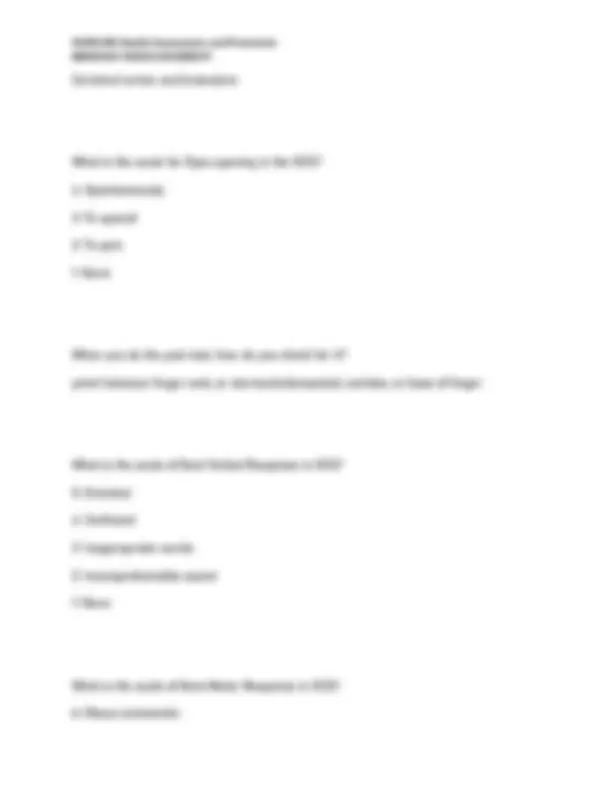
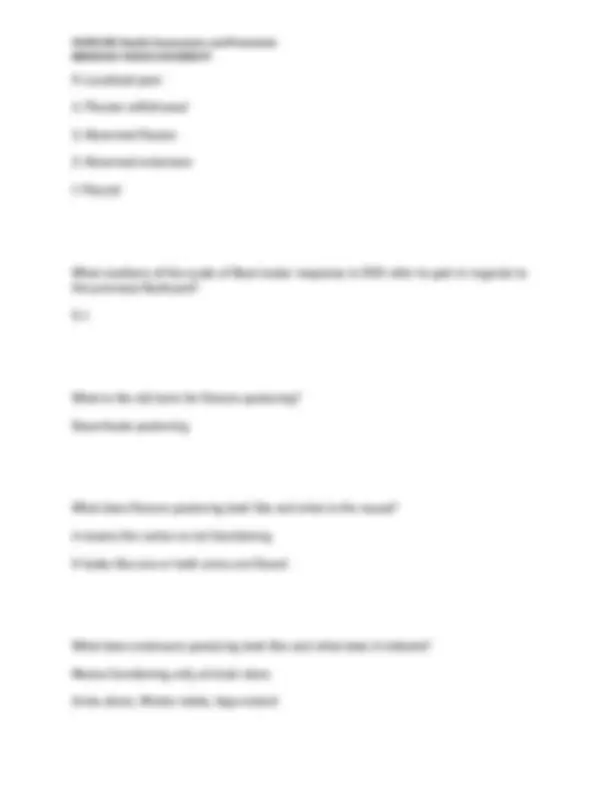
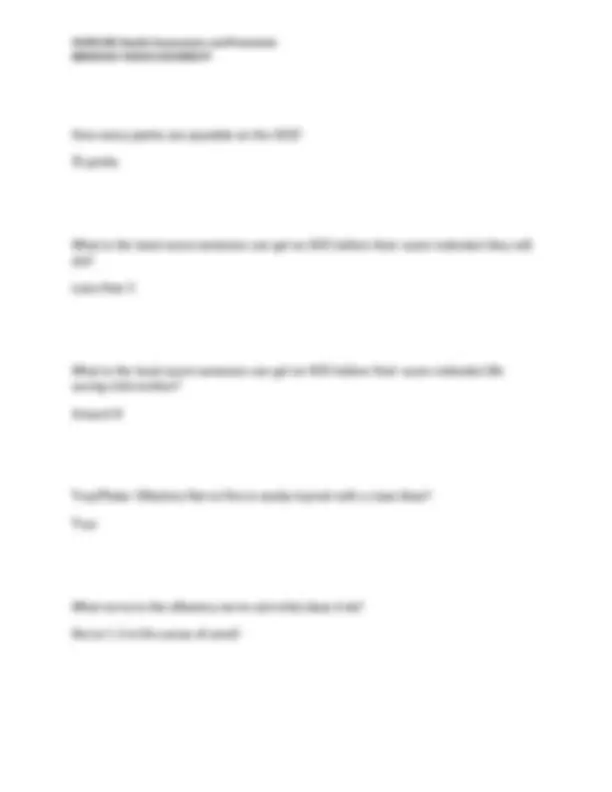
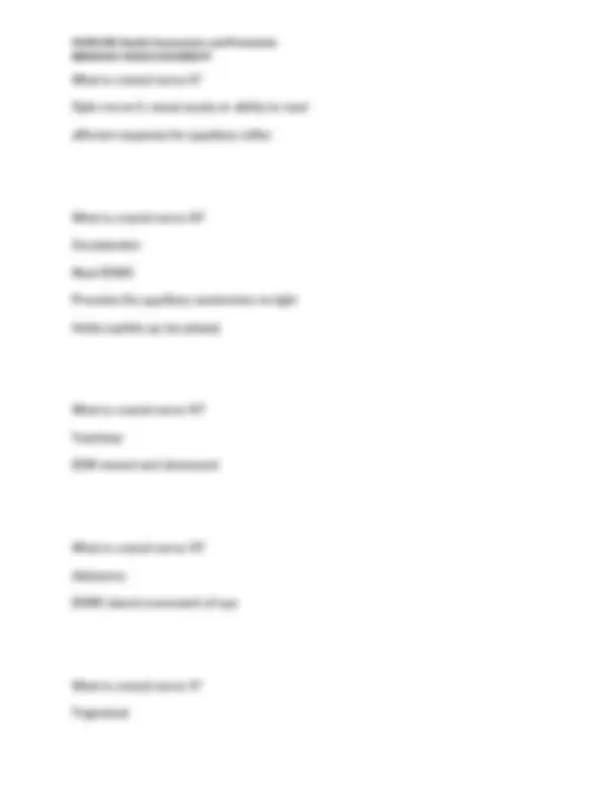
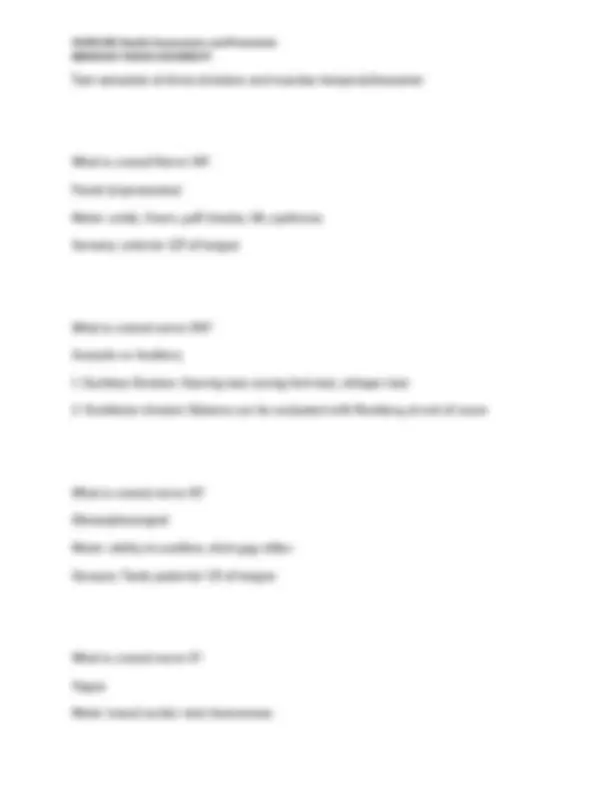
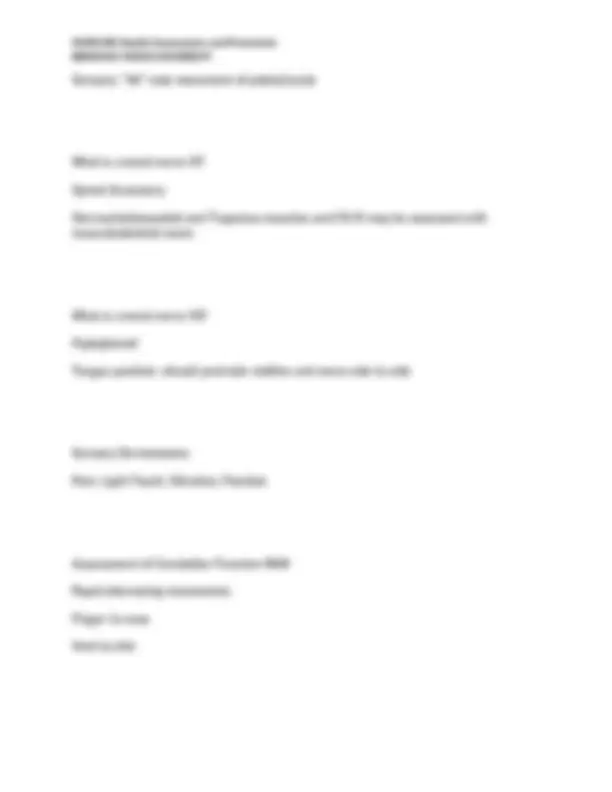
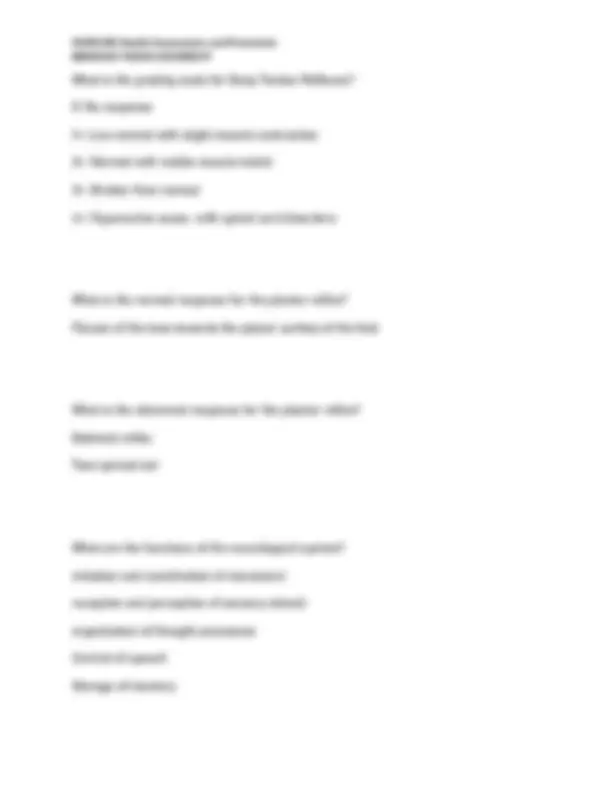
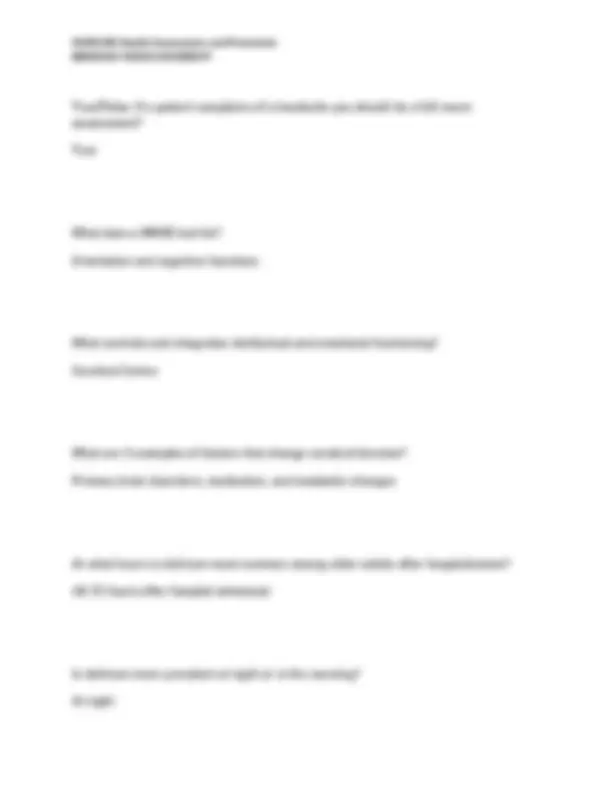
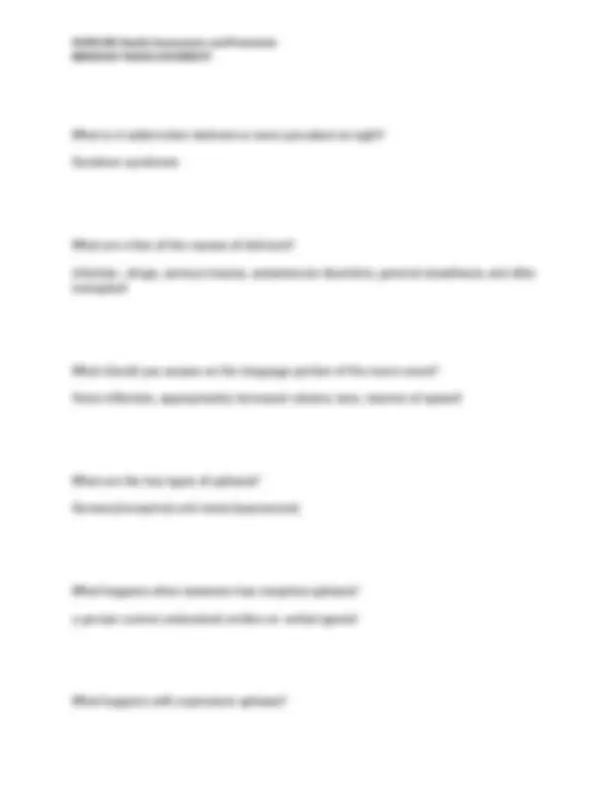
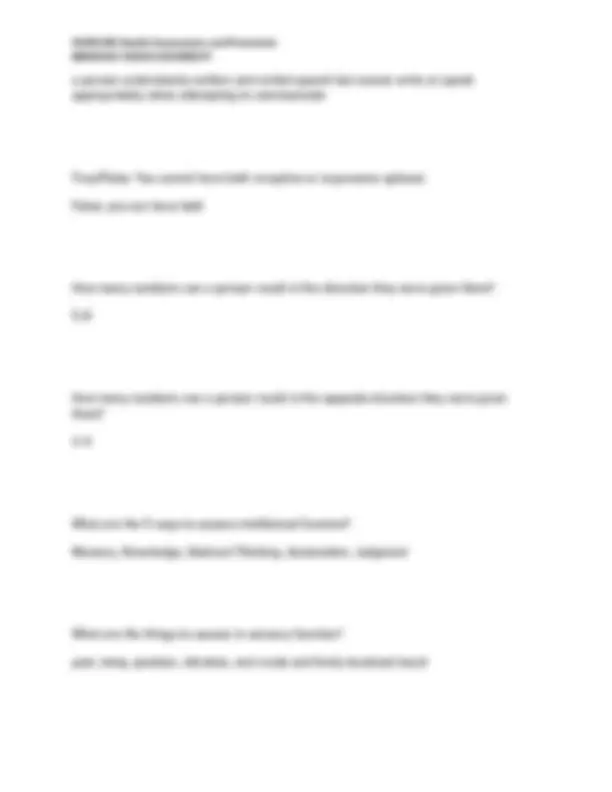
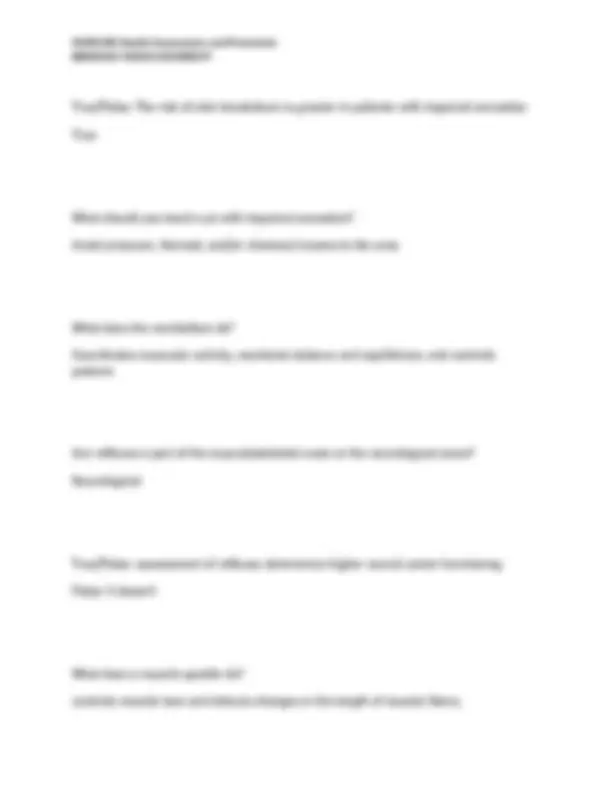
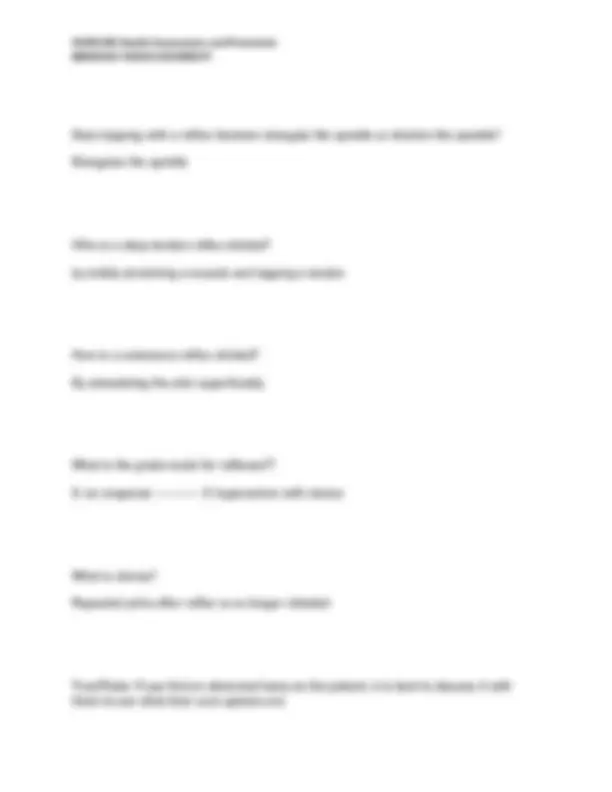
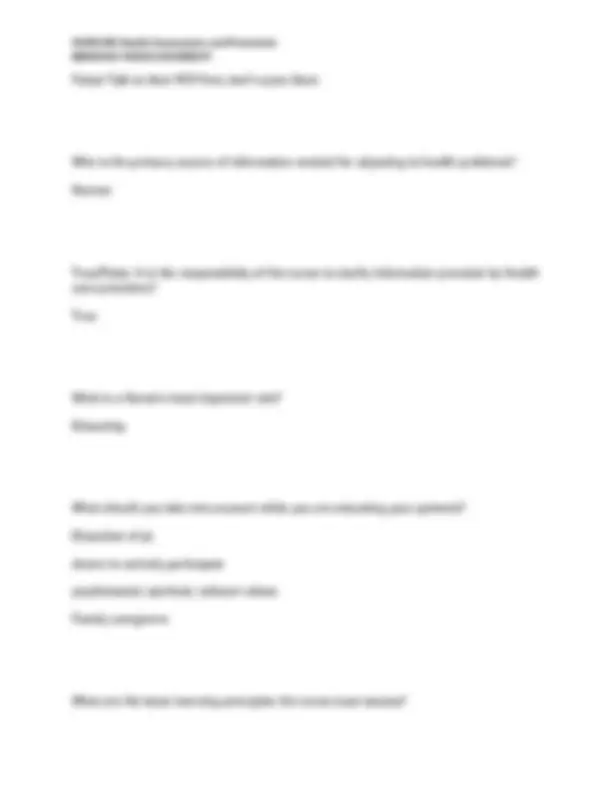
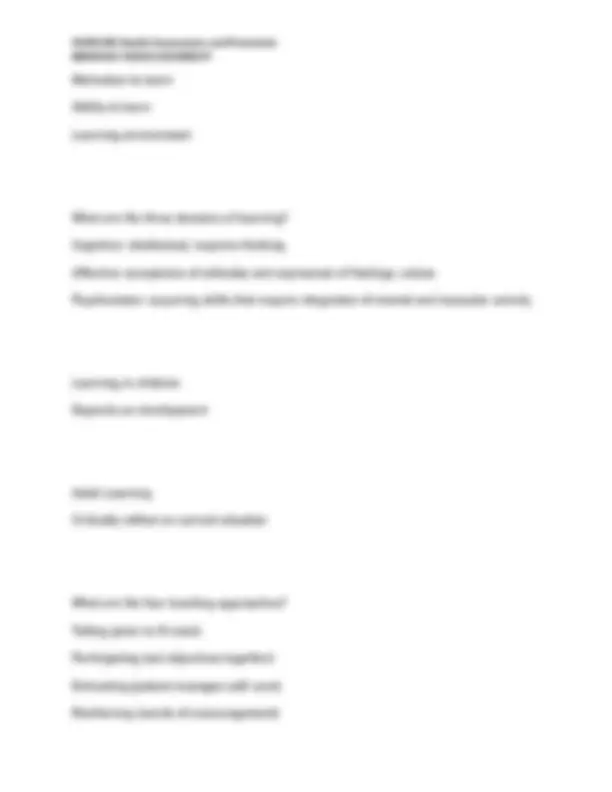
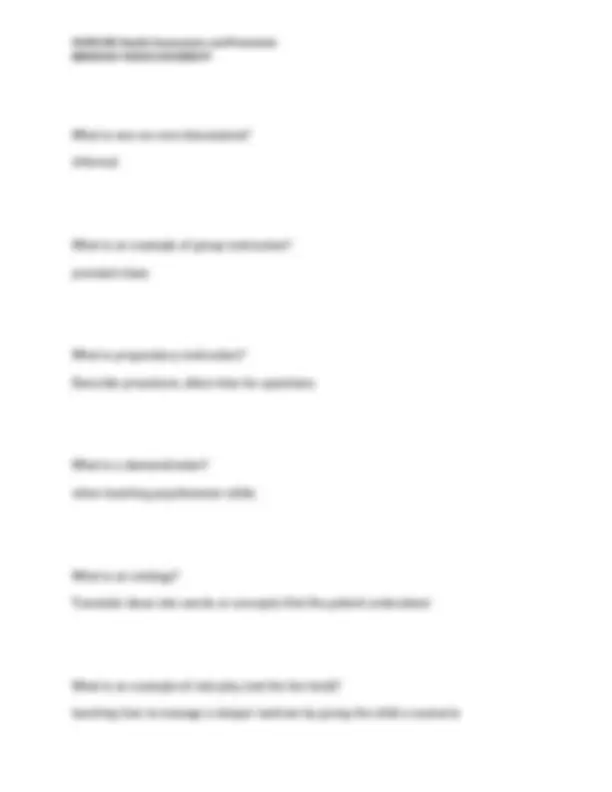
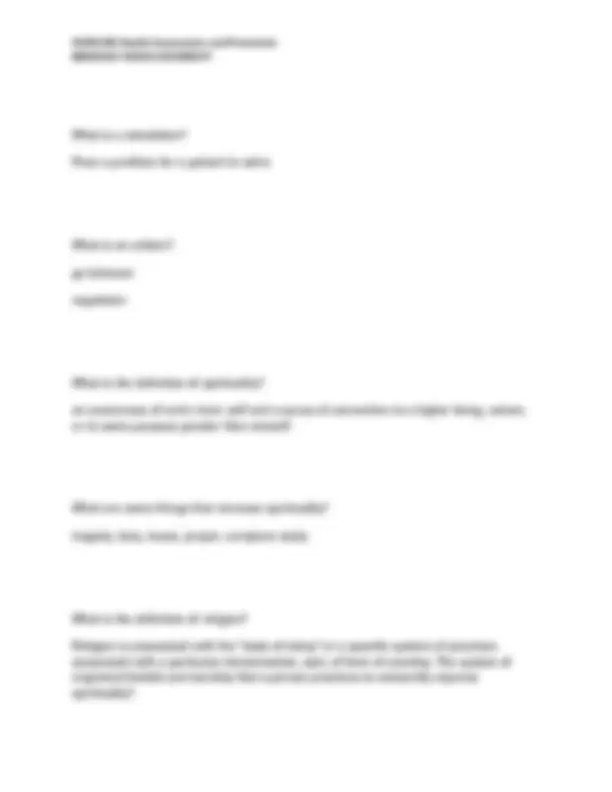
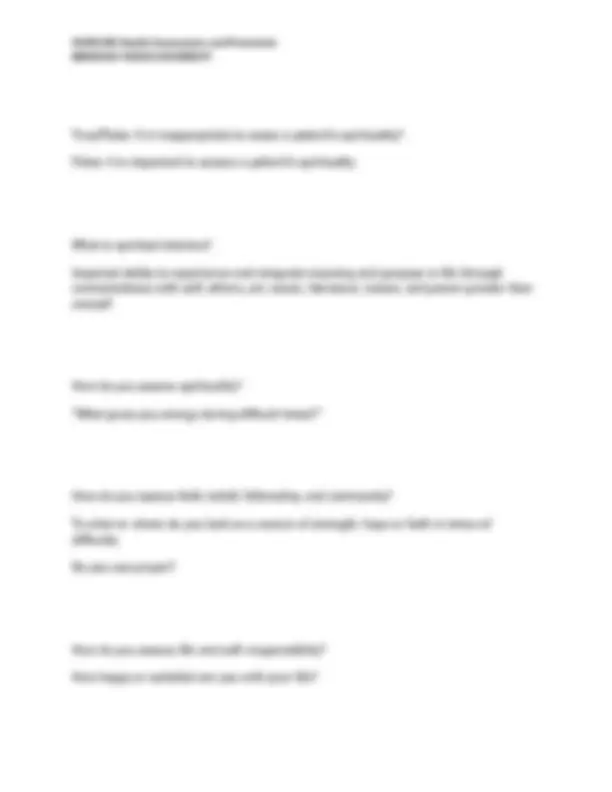
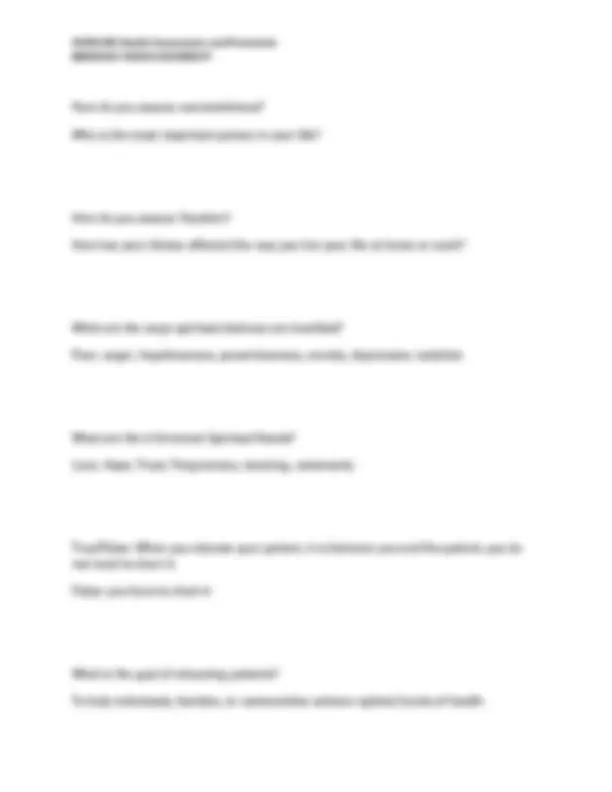
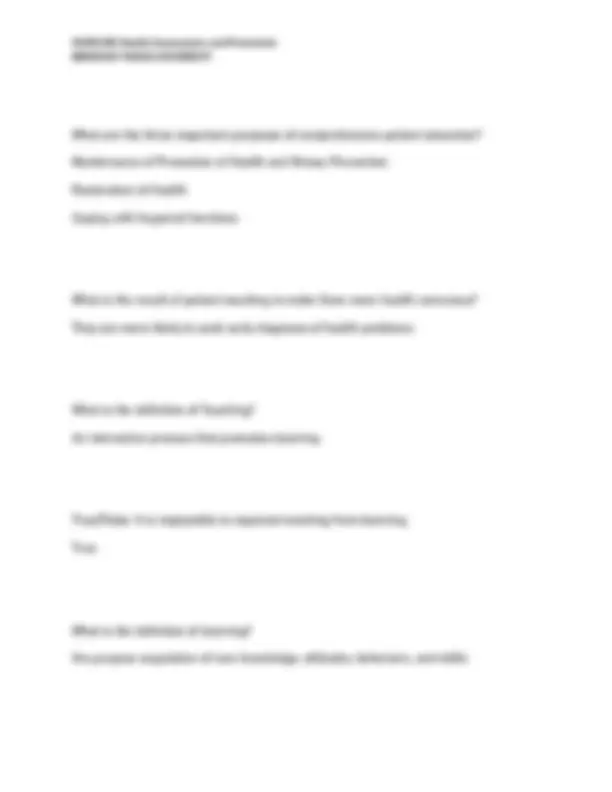
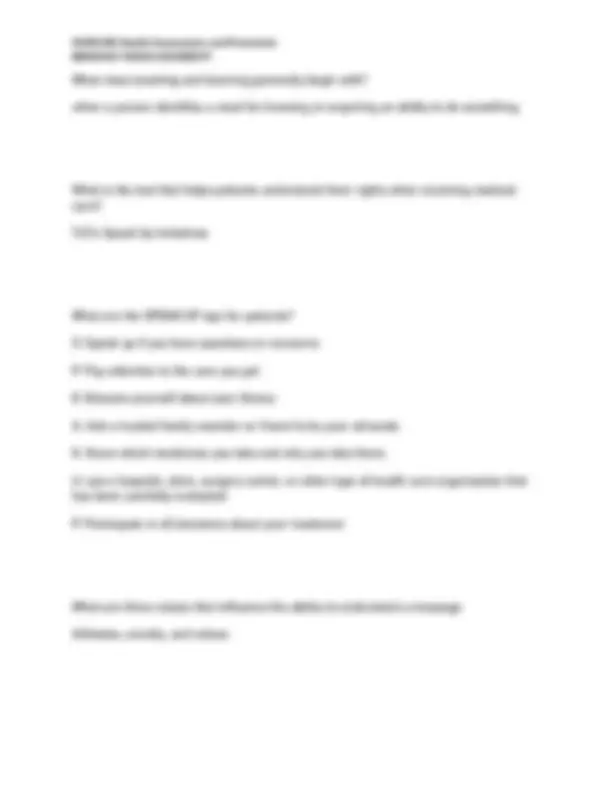
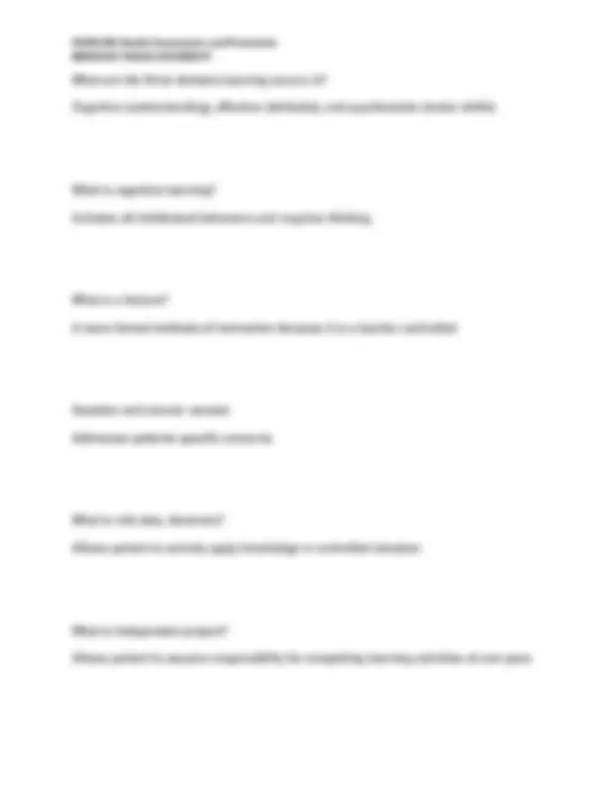
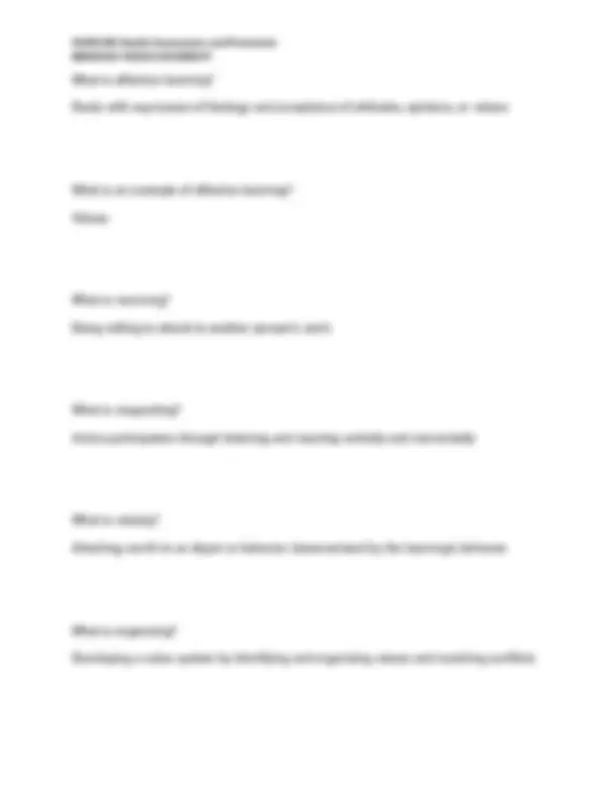
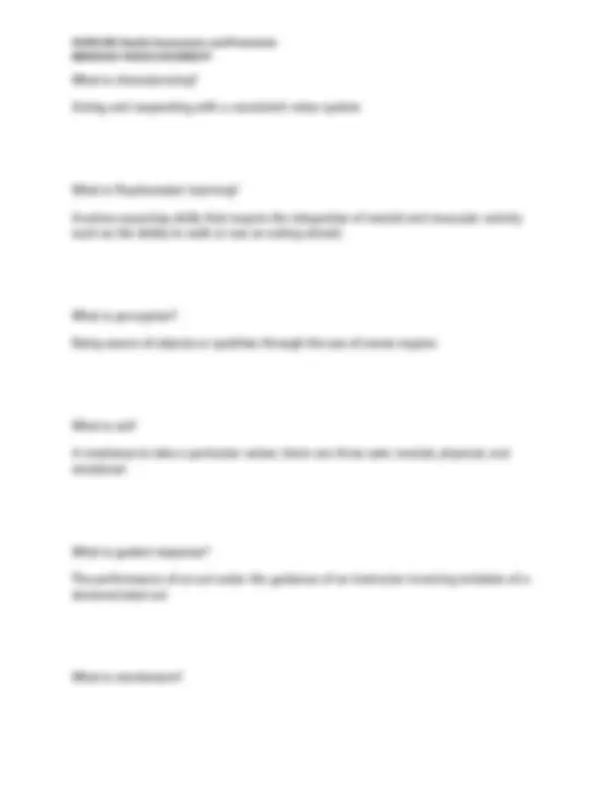
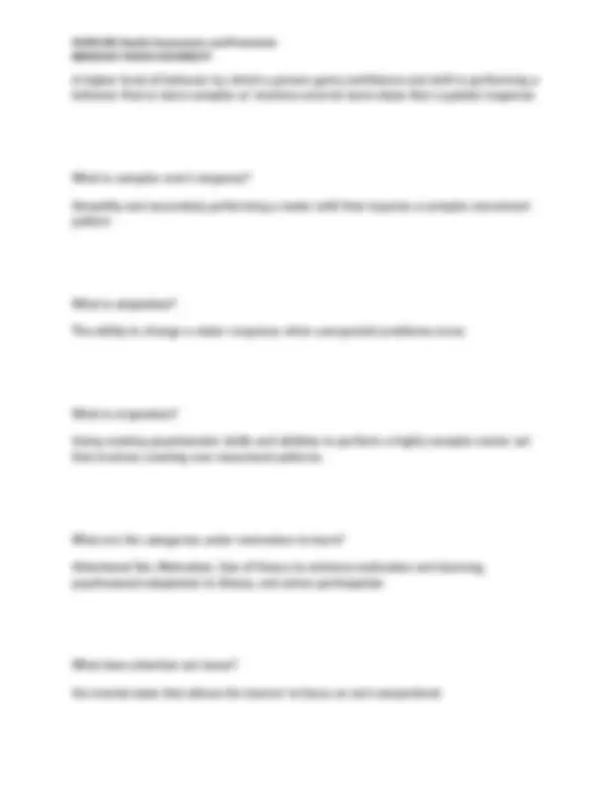
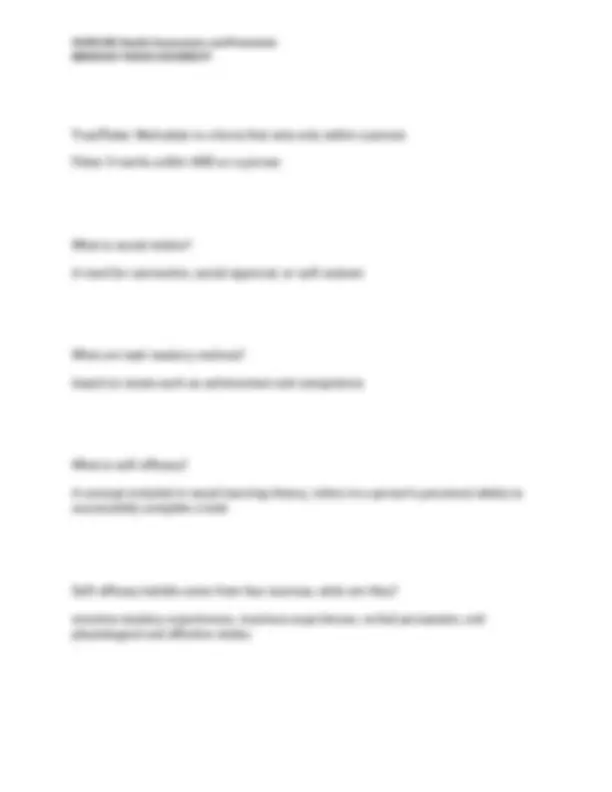
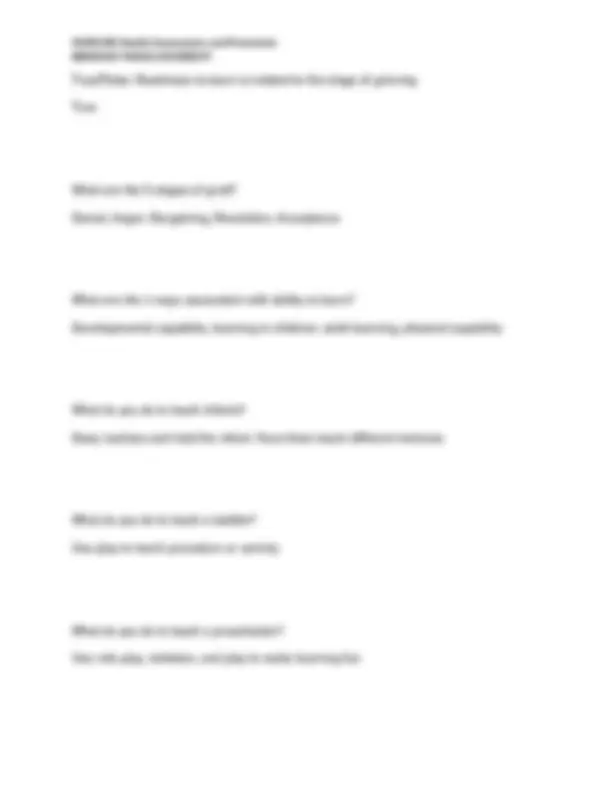
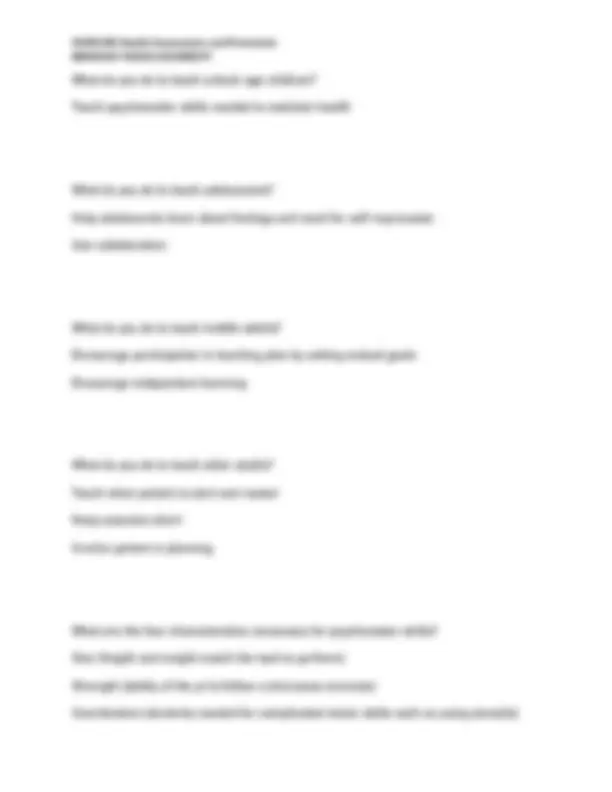
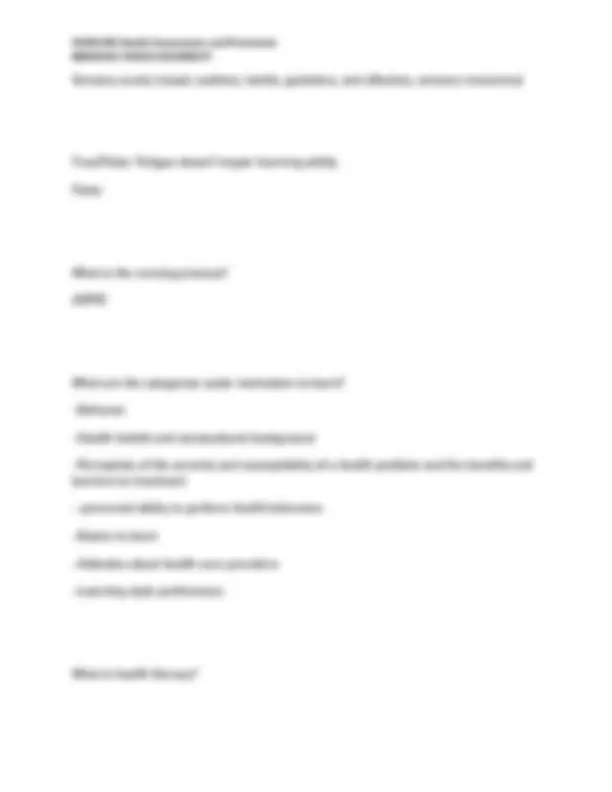
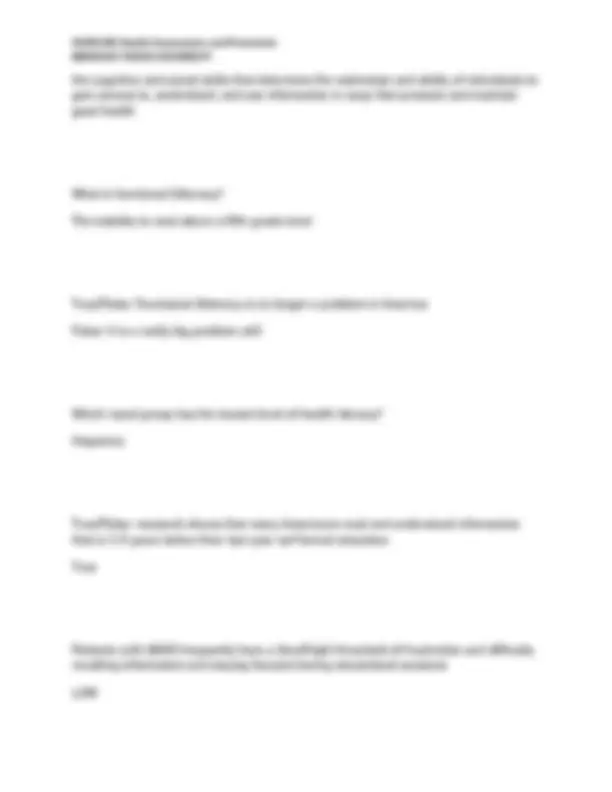
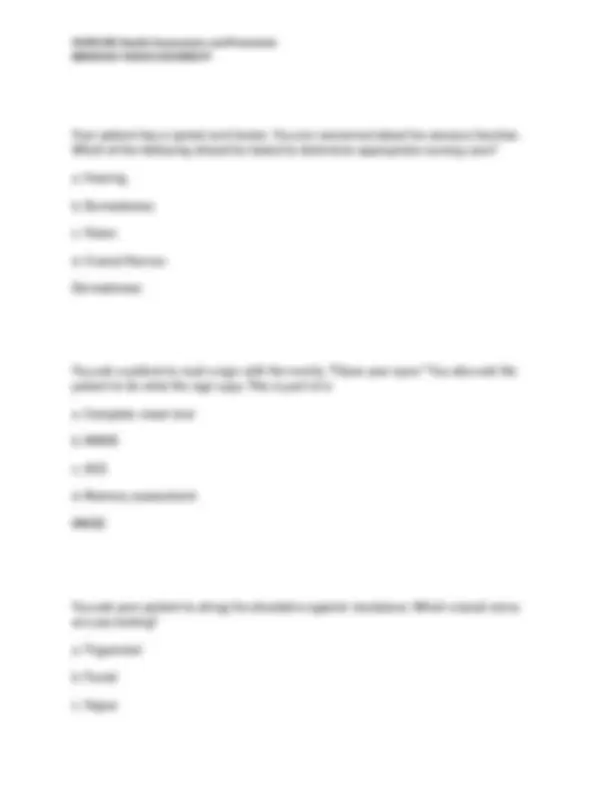
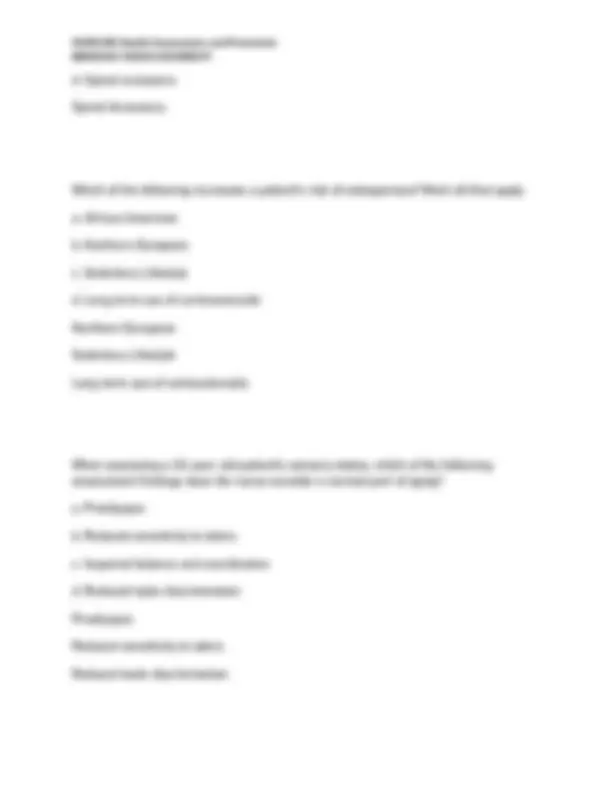
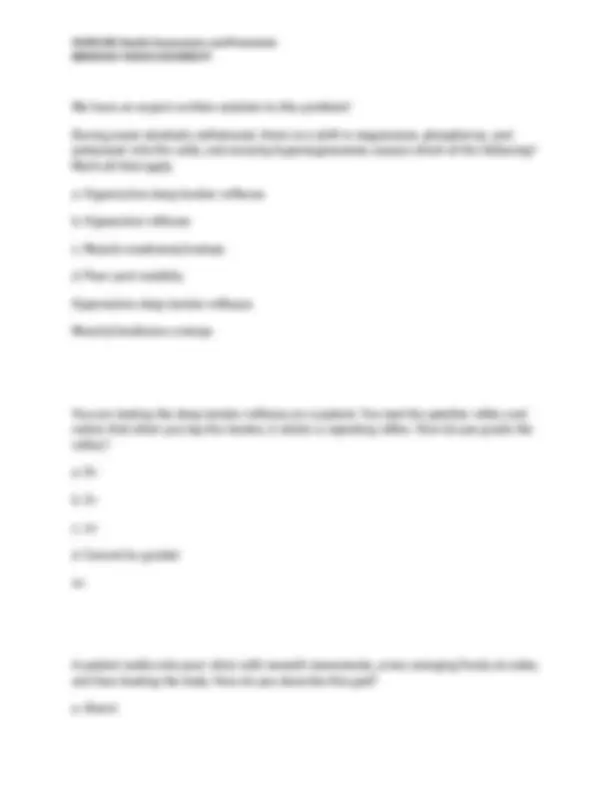
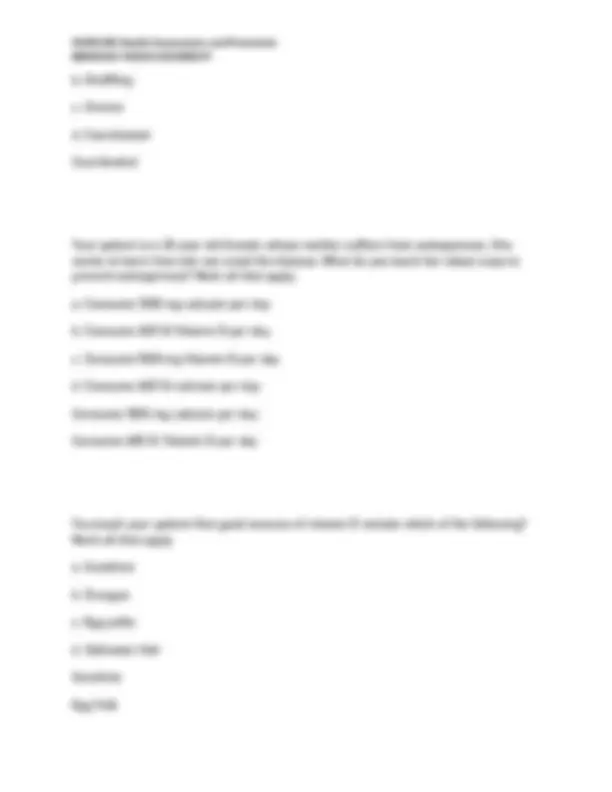



Study with the several resources on Docsity

Earn points by helping other students or get them with a premium plan


Prepare for your exams
Study with the several resources on Docsity

Earn points to download
Earn points by helping other students or get them with a premium plan
Community
Ask the community for help and clear up your study doubts
Discover the best universities in your country according to Docsity users
Free resources
Download our free guides on studying techniques, anxiety management strategies, and thesis advice from Docsity tutors
A comprehensive set of questions and answers covering various aspects of health assessment and promotion, particularly focusing on musculoskeletal health. It includes topics like scoliosis, kyphosis, lordosis, lower back pain, rheumatoid arthritis, osteoarthritis, and osteoporosis. Valuable for students studying nursing or related health fields, offering insights into common musculoskeletal conditions and their assessment.
Typology: Exams
1 / 68

This page cannot be seen from the preview
Don't miss anything!





























































BRIGHAM YOUNG UNIVERSITY
When you are checking for length, alignment, circumference, and position, what are you checking for? to see if they are all symmetric bilaterally What is active ROM? When the pt does it by themselves What is passive ROM? When you do it for the pt What nerve does the "turn your head against my hand" and "don't let me push your shoulders down" test for? Also, what muscles are being utilized? Nerve XI (11) Sternocleidomastoid and Trapezius
BRIGHAM YOUNG UNIVERSITY What muscles do we test in the upper extremities for strength? deltoids, triceps, biceps, hands What muscles do we test in the lower extremities for strength? Quadriceps (push on thigh) and Gastrocnemius (push on shin and calf) What three things do we inspect on the back to check for scoliosis? Shoulders, scapulae, and iliac crests True/False: To check for scoliosis you just inspect the back False: You also palpate the spine What are the two steps the pt has to take to check for scoliosis? a. Sitting and standing b. Sitting and bending over c. Standing and bending over d. Trick question, they have to sit, stand, and bend c. Standing and bending over
BRIGHAM YOUNG UNIVERSITY What can cause Kyphosis? osteoporosis What is the actual definition of Kyphosis? Exaggeration of the posterior curvature of the thoracic spine What is it called when you get scoliosis AND kyphosis? A super sucky situation For real: Kyphoscoliosis What is the definition of Lordosis? Increased lumbar curvature What does Lordosis look like? Leaning back Who are the two most common types of people to have Lordosis?
BRIGHAM YOUNG UNIVERSITY Kids and pregnant women What is the most common cause of job-related disability and missed work? Lower back pain What is the only thing more common than lower back pain out of the neurological ailments? Headaches How long does acute back pain usually last? A few days to a few weeks? How long does it have to last for it to be considered chronic back pain? more than 3 months What are the 6 risk factors for lower back pain? Obesity Smoking Excessive weight gain (pregnancy)
BRIGHAM YOUNG UNIVERSITY
BRIGHAM YOUNG UNIVERSITY OA: stiffness short and localized, short recovery Rheumatoid Arthritis vs. Osteoarthritis: Weakness RA: Pronounced weakness OA: not severe, localized Rheumatoid Arthritis vs. Osteoarthritis: Pain RA: pain even at rest, disturb sleep OA: Pain on motion; Relieved by rest Rheumatoid Arthritis vs. Osteoarthritis: Fatigue RA: severe OA: not common Rheumatoid Arthritis vs. Osteoarthritis: Emotional RA: depression and unbalance common OA: not common
BRIGHAM YOUNG UNIVERSITY b. gross deformity c. body enlargement d. alignment e. symmetry f. facial sensation g. joint mobility h. muscle size I. muscle strength f. Facial sensation (this is done in a neurological exam) Rheumatoid Arthritis vs. Osteoarthritis: Joint enlargement RA: joint enlargement moderate to severe OA: joint enlargement mild with firm consistency Rheumatoid Arthritis vs. Osteoarthritis: Characteristics RA: Systemic inflammatory disorder OA: Deterioration and abrasion of cartilage Rheumatoid Arthritis vs. Osteoarthritis: Familial? RA: Yes OA: Yes
BRIGHAM YOUNG UNIVERSITY True/False: Rheumatoid Arthritis is reversible? False: It is irreversible destruction In what percent of people do nodules develop for RA? 25% Where do the affects of osteoarthritis hit most? The top joints of your fingers (first and middle finger bones) True/False: Rheumatoid Arthritis is an autoimmune diease? True Where do the affects of rheumatoid arthritis hit most? The knuckles (metacarpophalangeal joint) What does Valgus look like Knees bend towards each other
BRIGHAM YOUNG UNIVERSITY Treatment Options for OA CAM Glucosamine Chondroitin Topical Capsaicin (anti inflammatory) Treatment Options for OA Surgery Knee arthroscopic Knee replacement Hip replacement What are the Risk Factors for Osteoporosis? Sorry, there are so many Female, Advanced age, White/Asian, Thin and small framed, Positive FM Hx, Low Ca++ intake, Early menopause <45, Sedentary lifestyle, Nulliparity, Smoking, Excessive ETOH, Excessive caffeine, High protein intake, High phosphate intake, medications, endocrine What is nulliparity? haven't had a baby yet
BRIGHAM YOUNG UNIVERSITY How do you avoid Osteoporosis? Begin in teen years Weight bearing exercises Adequate Ca++ and Vit D intake cessation of smoking balanced, nutritious diet What is the recommended Adequate Intake of Calcium for ages 14-18 year olds? 1300 mg/day What is the recommended Adequate Intake of Calcium for ages 19-50 year olds? 1000 mg/day How many boys and girls ages 6-11 don't get enough Ca++ 44% of boys 58% of girls How many boys and girls ages 12-19 don't get enough Ca++ 64% of boys
BRIGHAM YOUNG UNIVERSITY USP on label indicates that adequate elemental Ca++ is supplied and that it dissolves well in GI tract. What is the best dose from supplements of Ca++ 500 mg or less What are the common complaints of Ca++ supplements Gas Bloating Constipation What happens if you get in more calcium than necessary? Kidney stones True/False; Vitamin D is a lipid is a water soluble vitamin False: Vitamin D is a fat soluble vitamin What is the major biological function of vitamin D? Maintain normal blood levels of calcium and phosphorus
BRIGHAM YOUNG UNIVERSITY True/False: Vitamin D helps maintain a healthy immune system True How much, in percent, is the risk of cancer decreased by Vitamin D? 50% What three other things does Vitamin D do for us and the elderly?
BRIGHAM YOUNG UNIVERSITY False: it is more difficult What are the four food sources of Vitamin D? Egg Yolk Liver Saltwater Fish Fortified Dairy Products What are the factors the affect production of Vitamin D? Age Time of sun exposure Skin pigmentation Hoe does age affect the production of Vitamin D? Older people produce less vitamin D than younger people How does the time of sun exposure affect Vitamin D production? Closer to noon the more vitamin D your body makes
BRIGHAM YOUNG UNIVERSITY How does skin pigmentation affect Vitamin D production? Darker skinned individuals require at least 5 times as much sun exposure to form a given amount of Vit D Who is at risk for osteoporosis? The elderly Dark skinned What is a sprain? Injury to a ligament What is a strain? Injury to a muscle or tendon What is a ligament? Thick, tough, fibrous tissue that connects bones together. What are the most common sites for SPRAINS? Ankle, knee, and wrist